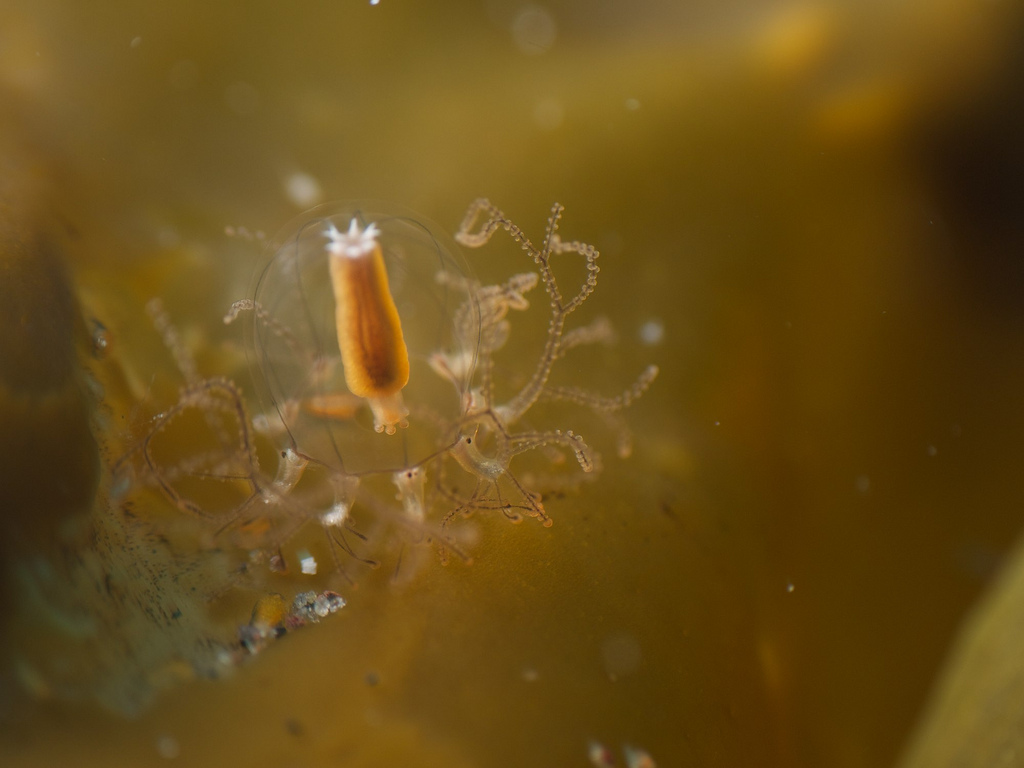Invasion History
First Non-native Panama (Pacific) Tidal Record: 2006Panama Invasion History:
Invasion history elsewhere in the world:
Cladonema pacificum has also been reported from Panama Bay, Panama where it was found in May, July, and December 2006 (Miglietta et al. 2008).
Description
The hydrozoan Cladonema pacificum has a minute attached polyp stage (~0.5 mm tall) and small, but more conspicuous planktonic medusa (up to 3.5 mm) (Naumov 1957; Rees 1982). The polyps have been observed in aquaria, growing on sand grains and the sides of tanks (Rees 1982). In nature, they were found growing on mollusc shells, among rocks and algae in the littoral zone (Naumov 1957). The polyps form creeping, non-branching colonies, with erect stalks bearing four capitate (ending in bulbs) tentacles each (Naumov 1957; Rees 1982). They release a medusa with a bell shape which is wider than it is high. The medusae have nine radial canals, each with a tentacle bulb with one adhesive and one regular tentacle. The largest medusae (3.5 mm in height) reported by Rees (1982) had up to seven tentacles on each bulb, with the ones most distal to the bulb being the oldest, largest and most developed, with scattered nematocyst batteries clearly evident. The tentacles have many branches – ‘those most proximal to the tentacle bulb and most recently formed were adhesive tentacles'. Therefore tentacles underwent a change in development from adherent tentacles, with their large terminal adhesive pad, to regular tentacles as medusae developed and matured. In medusae over 2 mm in height a slight peduncle began to form above the manubrium, which hung almost to the velar (velum) opening. The most mature of Rees' medusae had male gonadal tissue developing on the manubrium (description from: Rees 1982).
Taxonomy
Taxonomic Tree
| Kingdom: | Animalia | |
| Phylum: | Cnidaria | |
| Class: | Hydrozoa | |
| Subclass: | Hydroidolina | |
| Order: | Anthoathecatae | |
| Suborder: | Capitata | |
| Family: | Cladonematidae | |
| Genus: | Cladonema | |
| Species: | pacificum |
Synonyms
Cladonema uchidai (Hiro, 1958)
Potentially Misidentified Species
Native to California (Rees 1982; Mills et al., in Carlton 2007)
Cladonema myersi
Native to southern California (Rees 1982; Mills et al., in Carlton 2007)
Cladonema radiatum
Native to Atlantic, introduced in Padilla Bay WA (Rees 1982; Mills et al., in Carlton 2007)
Ecology
General:
Very little is known about the ecology of Cladonema pacificum. Based on the biology of the congeneric C. radiatum, the hydroid colonies produce medusa buds, which in turn develop into medusae that are released (Schuchert 2006). The medusae feed on zooplankton, and when mature release sperm or brood eggs. The eggs are fertilized and released as planula larvae. These planula larvae settle on a suitable substrate and develop into sessile hydroids. Naumov (1957) found the medusae of C. pacificum among littoral algae on rocky shores and the tiny hydroids attached to mollusk shells on the algae and rocks.
Food:
Zooplankton
Trophic Status:
Carnivore
CarnHabitats
| General Habitat | Marinas & Docks | None |
| General Habitat | Unstructured Bottom | None |
| Salinity Range | Polyhaline | 18-30 PSU |
| Salinity Range | Euhaline | 30-40 PSU |
| Tidal Range | Subtidal | None |
| Vertical Habitat | Epibenthic | None |
| Vertical Habitat | Planktonic | None |
Tolerances and Life History Parameters
| Maximum Height (mm) | 5 | Medusa height. Hydroids are 0.5 mm tall (Naumov 1957; Rees 1982). |
| Broad Temperature Range | None | Cold temperate-Tropical |
| Broad Salinity Range | None | Polyhaline-Euhaline |
General Impacts
No impacts are known for introduced populations of Cladonema pacificum.Regional Distribution Map
| Bioregion | Region Name | Year | Invasion Status | Population Status |
|---|---|---|---|---|
| PAN_PAC | Panama Pacific Coast | 2006 | Def | Estab |
Occurrence Map
| OCC_ID | Author | Year | Date | Locality | Status | Latitude | Longitude |
|---|
References
Carlton, James T. (Ed.) (2007) The Light and Smith Manual: Intertidal Invertebrates from Central California to Oregon Fourth Edition, Completely Revised and Expanded, University of California Press, Berkeley. Pp. <missing location>Cohen, Andrew N.; Carlton, James T. (1995) Nonindigenous aquatic species in a United States estuary: a case study of the biological invasions of the San Francisco Bay and Delta, U.S. Fish and Wildlife Service and National Sea Grant College Program (Connecticut Sea Grant), Washington DC, Silver Spring MD.. Pp. <missing location>
Hirai, Eturo (1958) On the species of Cladonema radiatum var. mayeri Perkins), Bulletin of the marine biological station of Asamushi 9: 23-25
Miglietta, Maria Pia; Rossi, Marco; Collin, Rachel (2008) Hydromedusa blooms and upwelling events in the Bay of Panama, Tropical East Pacific., Journal of Plankton Research 30(7): 783-793
Mills, Claudia; Marques, Antonio; Migotto, Alvaro E; Calder, Dale R.; Hand, Cadet (2007) The Light and Smith Manual: Intertidal invertebrates from Central California to Oregon (4th edition), University of California Press, Berkeley CA. Pp. 118-168
Naumov, D. V. (1957) [The life cycle of the hydromedusa Cladonema pacifica Naumov.], Doklady Akademii Nauk USSR 112(1-6): 194-195
Naumov, D. V. (1969) <missing title>, Israel Program for Scientific Translations, Jerusalem. Pp. <missing location>
Rees, John T. (1982) The hydrozoan Cladonema in California: a possible introduction from East Asia, Pacific Science 36(4): 439-444
Schuchert, Peter (2006) The European athecate hydroids and their medusae (Hydrozoa, Cnidaria): Capitata Part 1., Revue Suisse de Zoologie 113(2): 325-410
